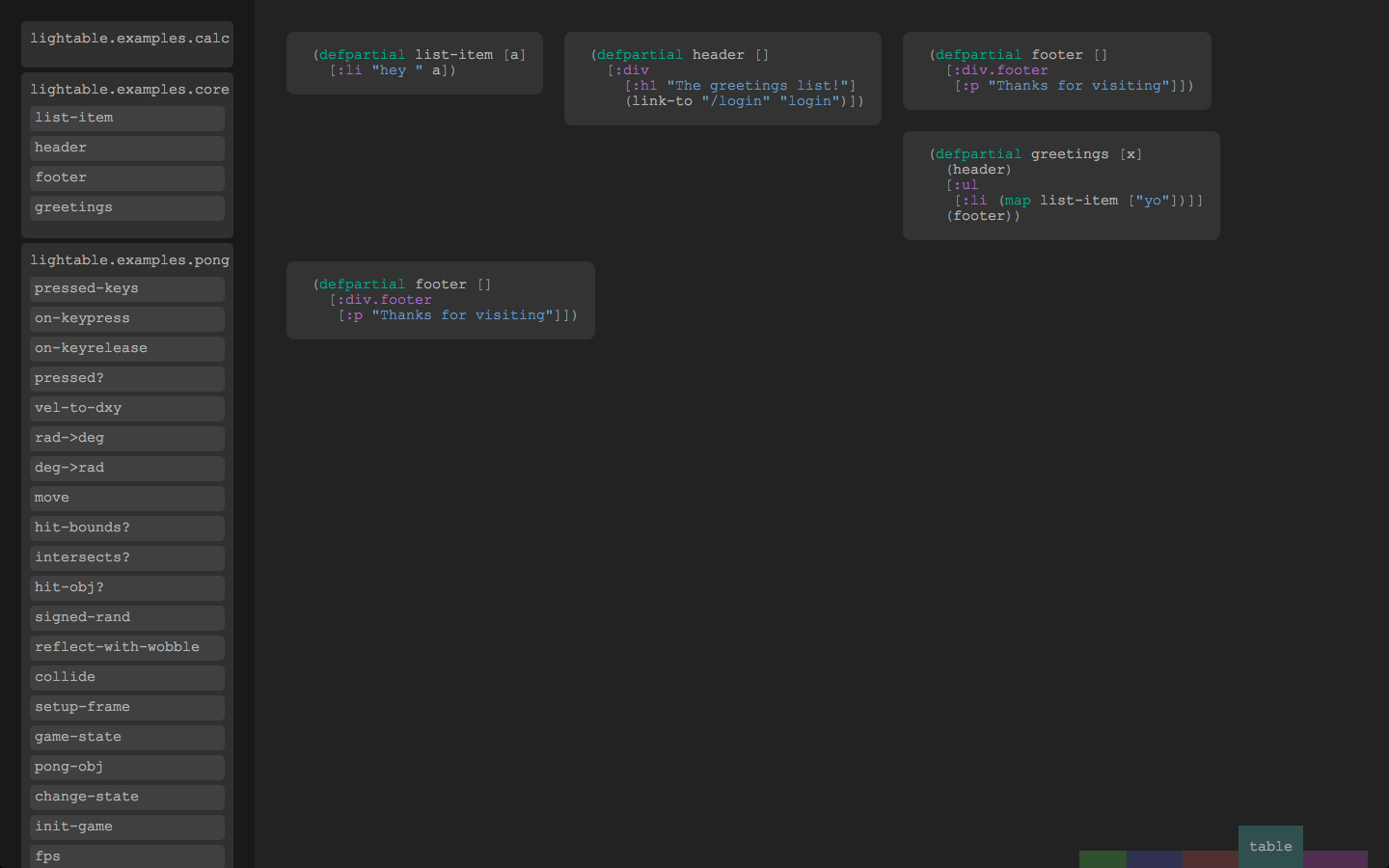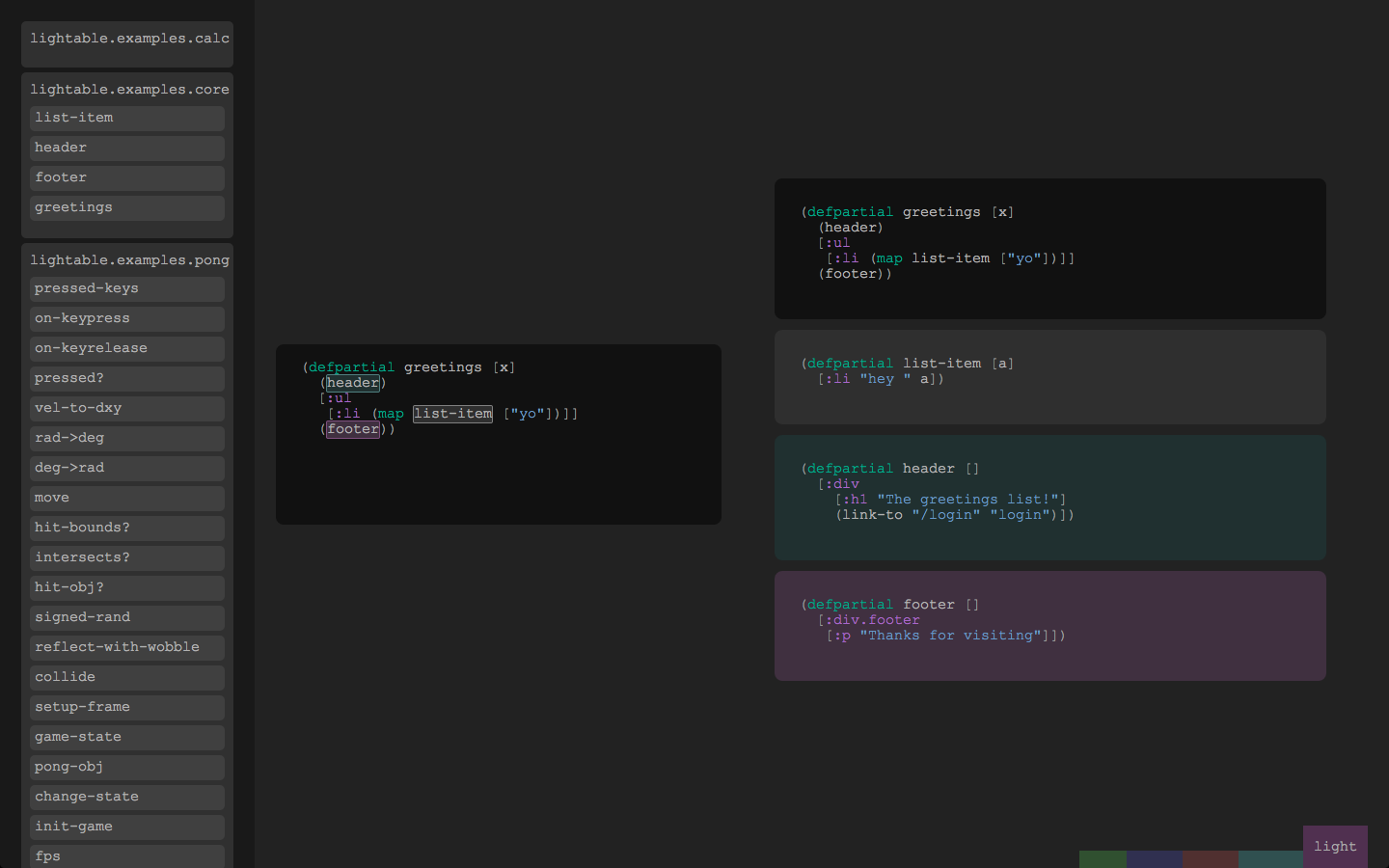IDE of a new type or Open-source project Light Table
Today came the newsletter with Kickstarter "Projects We Love". I decided to see what was new and I was immediately attracted by the Open-source label. I followed the link to read that the author of the project offers such an interesting and new thing and I liked it. Decided to share with Habr.
Light table
Recently, in the field of software, there is a fairly significant shift towards simplifying user interfaces. To the world of development tools, this extends less. On the contrary, the workspace itself is shrinking more and more, acquiring additional property and navigation panels.
For a long time, ideas have floated in the air that we can make the IDE better and more convenient. What are these ideas?
- You should not look for documentation anywhere and spend time on it.
- File structure is not the best representation for code.
- Editing should be available anywhere and the editor should show not only the code.
- With any change, we should see the result instantly.
- We should see more information about related pieces of code.
Let's see how these ideas are embodied by the Light Table.
')

(This is what the default development window looks like)
Documentation is everywhere
When you study a new code and come across a call to an incomprehensible function, you usually need to either go to the documentation or go to the function itself and read its description. In the Light Table it will be enough to hover the cursor over the function and you will see not only the description left by the author, but also the list of parameters and their order.

Or you need to quickly see where this function still occurs.

Instant feedback
You can see the results of your changes in real time. This allows you to try various input conditions in debug mode and see not only the result, but also how the variables pass through the entire code.

Composite Tables
What do we usually have? In one window, the code of a single file. Specialists from other areas have large tables, but they can lay out drawings and other tools to better see the big picture. Therefore, composite tables are a much better abstraction for us. After all, our code has a complex interaction. We should be able to focus on the most important and see things conceptually.

Why don't we see a working game right from the editor

Code highlighting
To better see how the code is organized in your program, the Light Table can not only highlight the functions being called, but also immediately show their code.

We do not need to constantly jump from one function to another, trying to understand their interaction.
This is especially convenient with the ability to see changes in real time.

What languages will be supported?
Initially, only Javascript and Clojure will be supported, but new languages can be added via plugins.
Details
The project is trying to collect 200,000 dollars.
At the time of this writing, $ 131,837 has been collected.
Half way passed.
More precisely and in detail painted on the project page on Kickstarter
UPDATE1
By Chris Granger: biography , github (thanks for the links ilya42 )
UPDATE2
At the moment, the project has collected $ 135 244 , i.e. for 9 hours (since the writing of the article) the amount increased by $ 3,407
I also wanted to give one of the comments from kickstarter:
It's sad to see that there is so little love for this project.
/ /
Wherever I write about the project, people reply “use Vim / Emacs”. I love Vim and I use it often, but what the hell?
/ /
I still think this is an interesting project, and I think it will help teach children about programming. I am sure you will succeed.
UPDATE3
I want to once again draw attention to the project description on Kickstarter . Nowhere does Chris Granger argue that these are his personal ideas and the “newest inventions.” He also refers to the Bret Victor mentioned in the comments.
He collects money for a project in which he is going to embody these ideas, and not under the ideas themselves.
I sincerely do not understand why this causes resentment.
UPDATE4
Already collected approximately $ 217,000. So the project starts. In total, about 5,000 people invested in the project. But people still hope to raise $ 300,000 to support Python . It left 15 days.
It will be very interesting for me to see what will come of all this.
UPDATE5
Light Table source code published
More news on Habré here
Source: https://habr.com/ru/post/142906/
All Articles